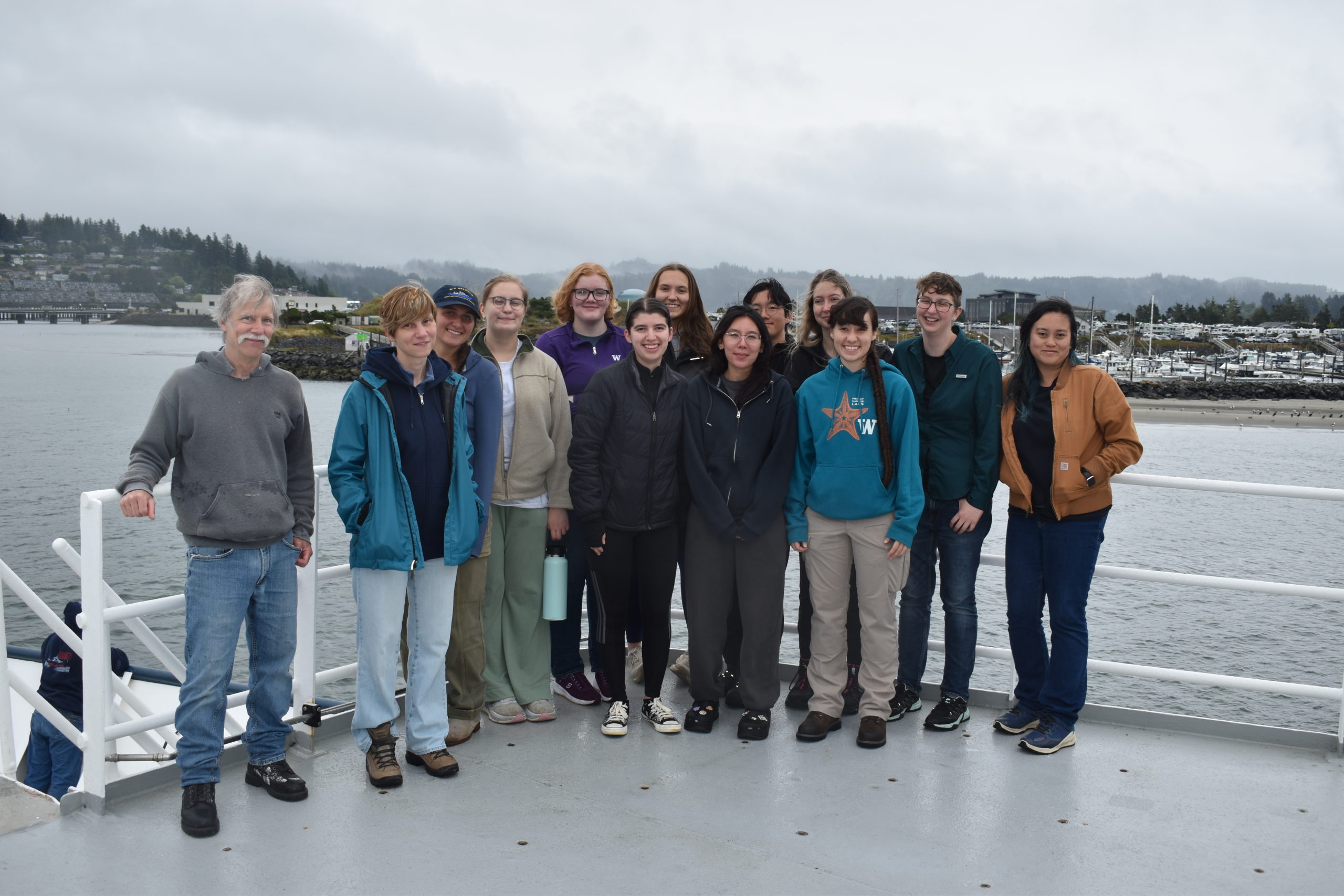
August 15th, 2025
It’s hard to believe that my time on the RV Atlantis is coming to an end. In some ways, time onboard has flown by in a blur of Jason shifts, meals, and lab work. But in other ways, it feels like we’ve been out here much longer. The days blur together; each one filled with new experiences, challenges, and unforgettable moments.
We started our journey with excitement and a healthy dose of uncertainty. I had no idea what to expect from ship life or my role on board, but I quickly settled into the rhythm of my two daily watch shifts in the Jason control van and started learning the ropes (quite literally in some cases). Seasickness made its inevitable appearance early on, and while I mostly dodged it the first few days, the long 20-hour transit to Axial Base hit me hard. I spent most of that day horizontal, missing meals, and questioning my ability to walk in a straight line ever again. But by the time we arrived at Axial, I was back on my feet and ready to dive into the action. At the ASHES vent field, I finally saw what I had been waiting for: towering hydrothermal chimneys, super heated vent fluids, and the unique textures of deep-sea geology. After days of watching silty, muddy bottoms on the monitors, the sight of twisted rock structures and shimmering black smokers was surreal. It was during those dives that I had a moment of inspiration: What if I could document how these structures have changed over time?
That idea has since evolved into a working project. Using the video archives from previous VISIONS cruises and this year’s footage, I plan to create a time-lapse video tracing the evolution of select chimneys, particularly “Inferno” and possibly “Mushroom.” I’ll focus on visual changes over the years and pair that with supporting data (like fluid chemistry and seismic activity) to try to understand what’s driving those changes. It’s a big project, and most of the heavy lifting will happen back at WWU and UW, but being here in person has helped me think through how I want it to come together.
In between all the science, we found time to make space for the little joys: watching the stars from the bow under skies clearer than I’ve ever seen, sharing photos of our many different pets that we can’t wait to get back to, and staying up too late playing chaotic rounds of card games in the library.
There have been a few disappointments. I missed every single whale sighting, porpoise sighting, and krill-mageddon, but I’ve learned that on a ship, you can’t catch everything. You have to sleep when you can, soak in what you can, and make peace with the fact that the ocean is always doing something, whether you’re watching or not. Looking back, I’m honestly just grateful. The long hours and the constant stream of new experiences have made this trip one of the most impactful academic experiences I’ve ever had.
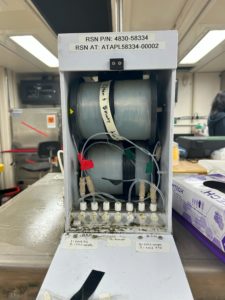
August 14th, 2025
I woke up very annoyed at my alarm until I remembered why I set it so early. There had been whale sightings the last two mornings, and I had managed to sleep through both of them. This time, I was determined to get up and try my luck. Unfortunately, I spent a little too long piecing together why I’d set that alarm, leaving myself with just a few minutes to look before a quick breakfast and the start of my shift. No whales in sight this morning, but at least I was awake.
My shift began in the van, where I spent the second half of an eight-hour dive watching the live recordings. We surveyed near some cool methane seeps, swapped out the digital still camera at Einstein’s Grotto, and recovered uncabled instruments just north of the site. Lacie collected two more Niskin bottle samples from the methane seep bubbles and background water. After a quick lunch, I helped her with her sample, filter, and clean up. Our sampling and filtering process was disrupted a bit because the other half of the lab was being used to collect chlorophyll samples, which unfortunately have to be done in very low light to preserve the amount originally in the sample. This is especially important for chlorophyll since it will photosynthesize with enough light. When sampling for metabolites on the other hand, the lack of light was more of a hinderance as we had the delicate task of removing the thin layer filtering the samples and placing them in tubes that will be frozen so they can be analyzed at a later date. It’s the most lab work I’ve done in days, and it was nice to get back into it. Speaking of lunch, it was done on a grill out on the deck, which was unexpected, but just as delicious as usual. I missed the student meeting as I was still helping Lacie, but it was an engineering talk led by Adam from the Jason team.
Just before dinner I helped Mariela in her lab again, this time observing her checking her standards for the samples. It is important to check whether your standards are reacting how they should, so they do not interfere with your results. Adding on to the lab work theme, I assisted with CAT sampling. It’s a very complexly organized connection of tubes and waterflows that I won’t pretend to understand. Best I could gather is that it can be used to determine fluid compositions with a tracer, from which flow into/out of the sediment can be calculate. I finished out my shift with the last dive of Leg 1! I cannot believe we are heading back to Newport tomorrow. This trip has been such a whirlwind and I’m so grateful to have had this opportunity.
August 13th, 2025
After an exciting night of stargazing, I overslept by a few minutes this morning (not for the first time), only to find that we were once again on a weather hold. We hung around for about an hour before the decision was made to head back to Slope Base to retrieve and unplug the science pod we had deployed on a previous dive as it had stopped transmitting data.
I had a late breakfast and spent some time catching up on my blog before we got back to work. The dive to cut and recover the pod was a short one, but it was fascinating to watch. Jason doesn’t usually use cutting tools, so seeing the ROV in action like that added some excitement to the otherwise routine recovery.
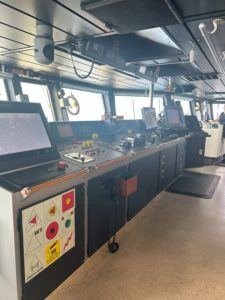
Later in the day, we had a tour of the navigation bridge. It was really interesting to learn about the various ways the Atlantis can be steered, and how those methods have evolved over time. The controls have become much more precise since they started using Jason more, as it requires finer maneuvering than the HOV Alvin did. Everything is now fully electronic (no surprise there) and I was interested to learn how many systems are duplicated as backups in case anything fails.
We’ve had a series of short transits recently as the schedule keeps shifting to accommodate weather, technical issues, and of course, the looming threat of another krill-mageddon. All the changes and motion have left me feeling a bit queasy and pretty drained today. I managed to sneak in a quick nap between our student meeting and dinner, then returned to the main lab to wait for my shift.
With another Jason dive delayed due to more tech issues, my shift ended up being quiet and low-key. I used the time to work on a one-page project outline to help clarify and organize my ideas moving forward. The last couple hours I played some card games before everyone went to bed.
August 12th, 2025
I woke up to the sound of my berth mates returning, buzzing with stories. Apparently, I’d slept through krill-mageddon. A surreal moment when a swarm of krill messed with the ship’s intakes. Intakes take in water for things like mechanical or electrical cooling, but with all the krill attracted to the ship’s lights, it was taking in a bunch of krill along with the water. It sounded wild, and I was genuinely bummed to have missed it. To make matters worse, there was also a whale sighting. So basically, the takeaway here is: I should never sleep again.
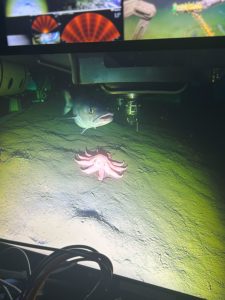
When I finally got up and started my shift, we were preparing for another Jason dive, this time at the OR Offshore site. I was rewarded with a lot of cod photos. They were very interested in our work at the bottom and kept getting in the way of the camera. Personally, I thought they made the photos even better, but not everyone agreed. I know I talk about lunch a lot, but it is one of my highlights of the day. Today was Taco Tuesday and it did not disappoint. After lunch I spent some time in the lab working on my blogs and hung out until the student meeting. Today’s meeting was led by Dana Manalang from the Applied Physics Lab.
Back at Southern Hydrate Ridge, I logged another Jason dive during my evening watch. This time, however, it wasn’t just about observing. Students got the chance to take turns operating Jason as we surveyed the seafloor. I have to say, it was by far one of the coolest things I’ve ever done. Navigating Jason turned out to be surprisingly simple. Despite all the buttons, joysticks, and dials in front of me, I found myself locking in fairly quickly. I have to give credit to all those hours I spent playing video games with my uncle. Who knew I was gaining skills I would be able to use here! The responsibility of piloting this high-tech piece of equipment felt pretty intense. But once I got into the zone, it almost felt like I was in a video game. The whole experience was a mix of awe and adrenaline, and something I will not be forgetting anytime soon.
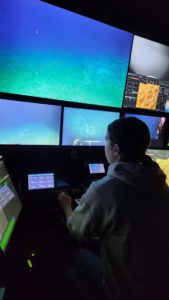
Afterwards I was determined to see some stars, so a group of us went to the bow for a while to see what we could see. I was really hoping to see some meteors from the Perseids, and luckily, we did. I also identified the Big Dipper, Perseus, and Pegasus constellations. I could watch the stars all night and the lack of light pollution this far from shore made it one of my best star viewing experiences.
August 11th, 2025
The days have really started to blur together. When I try to recall what happened when, it’s all a bit of a fog. I know things happened, but placing them on a timeline is a little difficult. Lately, I’ve been feeling pretty normal, just constantly tired.
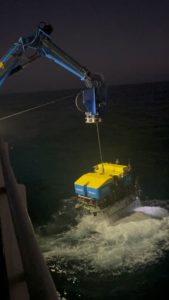
I started the morning with a Jason shift, followed by yet another delicious lunch. We had our usual student meeting, but this time with the captain, which was a real highlight. It was fascinating to hear his story and get a glimpse into his experience on the water.
I haven’t really felt like writing or doing much on the computer, which only adds to the timeline confusion. I managed to squeeze in some laundry before dinner and took another shower. Honestly, the showers are way better than I expected out here.
After dinner, I caught up with my mom for a bit before heading into my next shift. I spent a couple of hours in the Jason van as they wrapped up a dive, then made my way to the main lab. The seas picked up during transit, and I did my best to stay upright as we rocked along. I think we were heading to Southern Hydrate Ridge, but with all the short overnight transits, it’s hard to keep track. I wanted to check out the stars, as the peak of the Perseid meteor shower should be soon. However, it was too light when I checked during shift and then we started transit, and I didn’t want to be on deck with the boat rocking so much. I am hoping to try again tomorrow.
While in the lab, I killed some time practicing my card shuffling and working on my bridge technique. Later on, we labeled nutrient sample bottles, which basically meant matching scannable codes to bottle numbers—simple but oddly satisfying work.
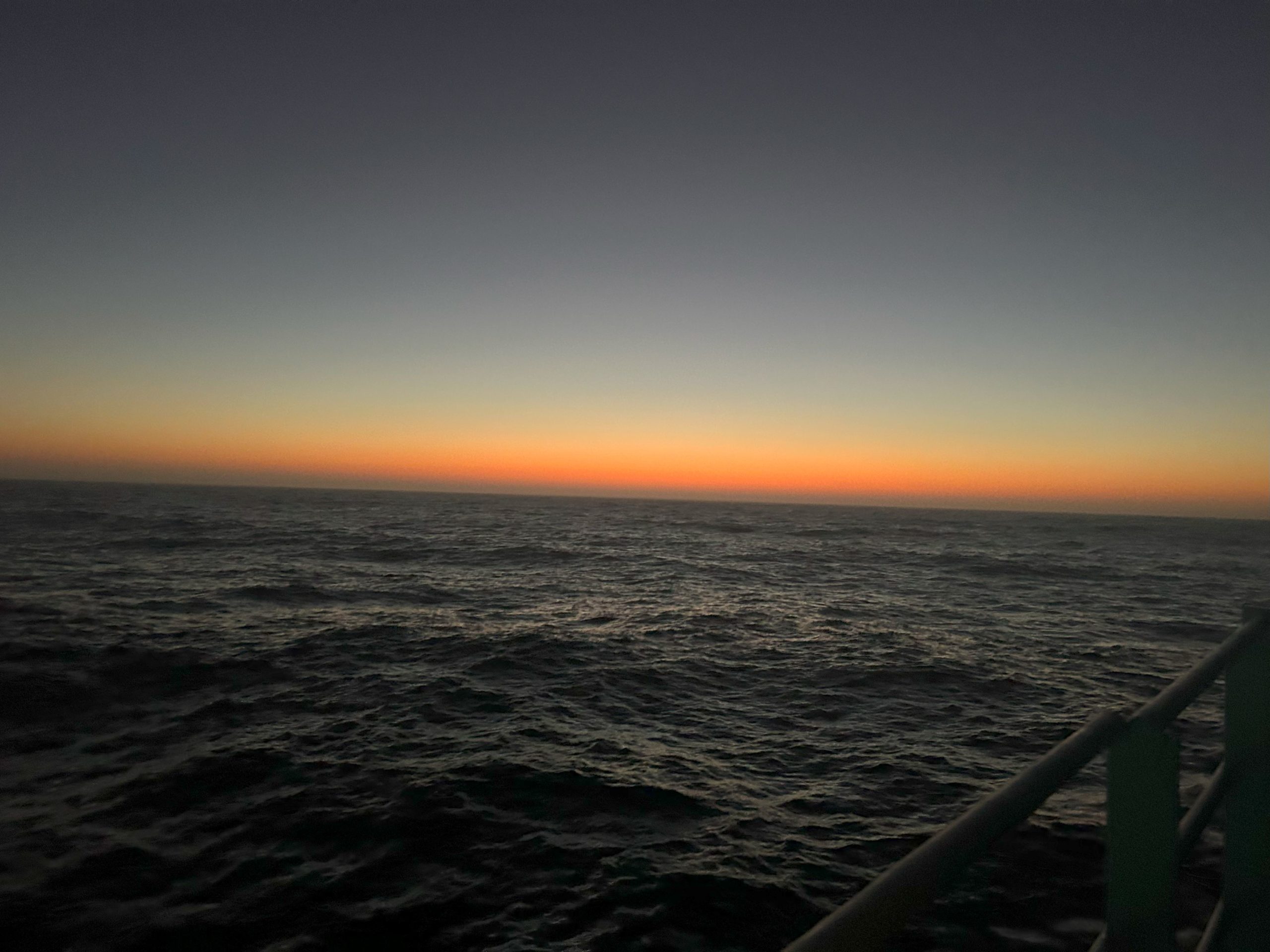
August 10th, 2025
We are back in transit heading to the slope base again. Somehow, I managed to sleep straight through my entire shift and got a solid 11 hours of sleep in one go. That’s basically unheard of on a ship, and I’m feeling pretty guilty about it… But clearly, I needed it.
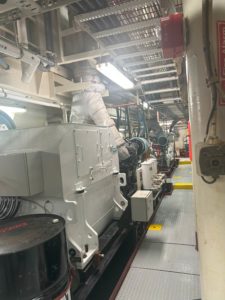
This time, I came prepared: snacks and plenty of water to carry me through lunch in my berth. (Let’s just say last time was… a learning experience.) I woke up around 1:30 just in time for the engine room tour, which was incredible. Seeing the machines that keep this ship running was such a cool behind-the-scenes moment. After that, I decided to hang out in the lab until the merch sale at 3:15. Honestly, I was a little worried that if I went back to lie down, I wouldn’t make it back up the stairs in time. Overall, I’m feeling way better than I did during our first transit, still not 100%, but definitely more functional. The ride felt a lot shorter this time, though that might just be because I slept through most of it.
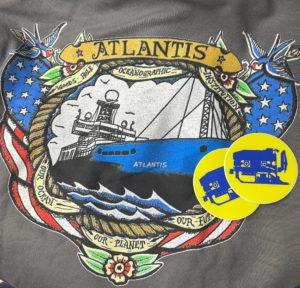
We stopped around midday, but there were still no dives due to weather. We can hear the waves crashing into us and the boat has definitely been swaying a lot more compared to previous days. I spent some time looking at some of the footage from this trip for my project, trying to narrow down the sections I will need for the timelapse. Accessing the full archive of videos while on the ship is difficult, so I’m just trying to get an idea of what dives I will need footage from. “Mushroom” is a very recognizable chimney in the ASHES field, but it has also been documented a lot, with similar timelapse videos as what I want to make. I’m thinking I will do its neighbor, “Inferno” which, at least on this trip, has been far more active.
After dinner, a group of us gathered for card games. What began as a few intense rounds of speed solitaire quickly switched to cribbage, a possibly invented version of speed whose rules don’t match anything we found online, and a delightfully confusing game of Mao. We played late into the night, but it was a nice way to unwind. I’m hoping the weather dies down soon so we can get back to doing Jason dives, but the day off was a welcome break.
August 9th, 2025
I was supposed to start my watch with a Jason dive around 9am, but it got delayed. So instead, I spent some time in the lab with Mariela, assisting with Winkler titrations to measure dissolved oxygen in seawater samples. We used starch as the indicator in our titrations, which turned the solution a deep purple before we slowly added the titrant. The goal was to titrate until the solution turned clear, but that endpoint was really tricky to call.
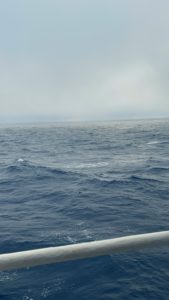
Definitely one of those processes where you can easily talk yourself into the wrong answer. It was my first time seeing an automated titrator before, as I’ve only done titrations by hand with a burette before, so it was interesting to see the process mostly automated. With the data we gathered, we were able to estimate the oxygen minimum zone, which is a layer in the water column where oxygen levels drop to their lowest.
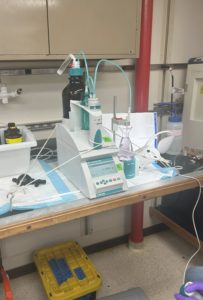
Jason ran into some technical issues that delayed most of the dives, so the pace on board slowed down quite a bit. After my time in the lab and catching up on my blogs, I took advantage of the lull with a much needed nap before dinner. I went back on watch at 8pm and Jason was back online with some short dives to the Deep Profile Mooring. I spoke with a few people about the logistics of my research project and whether I stop at creating a timelapse video or go further by incorporating other data we’ve collected, such as temperature, salinity, etc., to explore the processes driving the changes I’m observing in the vents. While the final scope depends on time, I do plan to investigate possible explanations for these changes, supported by data. Most of this will take place off the ship, since it will be easier to access the archive of data at UW.
We are starting the long transit back to the slope base. There is going to be some poor weather the next couple days, so we also have that to look forward to. I fully expect to have another day of sleep to avoid the nausea, but we will see. Perhaps I will get lucky…
August 8th, 2025
Finally… rocks! After days of watching the flat, muddy bottom and thick microbial mats across the monitors, we’ve arrived at the ASHES vent field on Axial Seamount—and I’ve finally found my project.
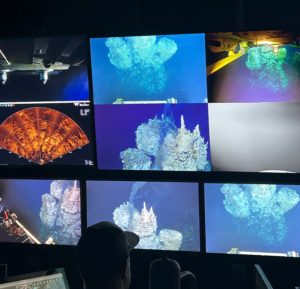
As I stared at the twisting chimneys, boiling water, and strange textures around the vents, I found myself wondering: What did this place look like a year ago? Or five? Or ten? Hydrothermal vents aren’t static; they grow, collapse, shift, and change constantly. All this to say, what if I could trace that transformation?
Turns out, I can. WHOI (Woods Hole Oceanographic Institution) has an incredible archive of video footage from this exact site, going back over a decade. I’ve decided to analyze how individual hydrothermal features, such as the “Inferno” and “Mushroom” chimneys, have changed over time. I’ll be selecting a few key sites, depending on the quality and availability of footage, and documenting the major structural and environmental changes year by year. I want to create a time-lapse video project that shows their evolution and, hopefully, tells a story about why those changes happened, whether it’s volcanic activity, shifts in fluid chemistry, tectonic movement, or even biological growth. Do I know how much work I’m getting myself into? Probably not. But honestly, I am very excited about it!
Today’s dives have been extremely long, and I have been going in and out of the van all day to see more. In the early evening, I helped Lacie collect her samples off Jason, including a bacteria sample and two Niskin bottles. I held the Niskin bottles and controlled the start and stop for the water from each sample; Three rinses with the samples and then fill. The bacteria collection was going on at the same time out on the CTD deck. Once the samples were collected, we went back to her lab and started filtering. She is attempting to collect metabolites from deep-sea vent samples to compare to samples previously collected on the surface. These are the first of their kind done at sea, so it’s very exciting. I am far from an expert on anything biology, but if you pop over to Lacie’s blog, she explains everything much better. After the collection process was started, I left to cover the control van and watch the last dive. It was a pretty quick dive, and I still had time to help more in Lacie’s lab with another Niskin collection and filtering before going to bed just before 1 am.
August 7th, 2025
I truly do not know where I would be without tea. I start my day with dandelion tea to settle my stomach, move onto a chai tea to get me through my shift, usually another black tea somewhere around lunch, and then switch to herbal tea during my last shift. Those who know me know I have always been a fan of tea, but as someone who does not drink coffee, I have taken it to a whole new level.
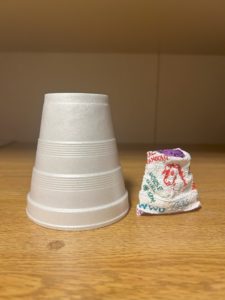
My day started with another delicious breakfast in the galley, that I am happy to report stayed down today. I joined yet another Jason watch, this one deeper than the past few, but still at the Axial Base. Once again just more silty mud at the bottom, but I am hopeful for rocks on the next couple dives. The silt did create some issues with visibility for Jason and slowed down the maintenance they were working on.
After another successful lunch, I helped Lacie in her lab prepare for her Niskin collection tonight. The Jason team wants to do back-to-back dives, which means we have limited time to collect Niskin samples before the bottles have to go back on for the second dive. Luckily there were some extra Niskins to practice the fastest method of collecting her samples. I spent the next couple hours decorating styrofoam cups for a CTD cast to bring home to some friends and family. When the CTD cast goes to 2600 m at Axial Base and the styrofoam cups go down, the pressure will cause the cups to shrink, making a cool souvenir. I still have one from one of my professors that made them for my class the last time she was here.
My last dive of the day with Jason was another long descent (2600m) to replace an LJ03A. After some issues replacing connections from the old node to the new node, the LV03A was swapped out and Jason resurfaced early the next morning. We then began a short transit to the caldera, which I was thankfully asleep for.
August 6th, 2025
I think the ocean wants me asleep. We started transiting shortly after I fell asleep, and I barely got out of bed in time for my morning shift. That was when I discovered that being fully upright came with a pounding headache and nausea. There are no dives happening since we are transiting to the Axial Base. It is about 20 hours from our previous site, and I think we started somewhere around 2 am. Since there was not much going on, I decided to continue resting in my berth, hoping to take advantage of the time to lie down. Unfortunately, that made getting up again very difficult. However, I persevered so I could get lunch and was rewarded for my effort by immediately throwing it back up. That was when I finally accepted, I would just sleep like several of my fellow students.
My watch on Tuesday night was very uneventful. The Jason crew were replacing HPIES on the seafloor. With it being so deep, that means that around half of my four-hour watch was just watching Jason descend to the bottom (2900m). We have started brainstorming our individual project ideas now that we have a better handle on the usual going-ons for the ship. I’m most interested in the Axial Seamount itself, so work on my project won’t really start until we reach it.
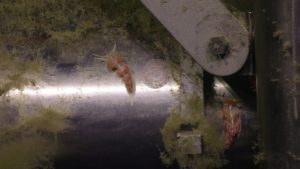
Around 8 pm, my berth-mate woke me up to ask if I wanted to go on watch. I immediately noticed two things. One: we stopped moving, and two: I was felt completely fine again. Marveling at how nice it was to be upright again; I walked to the control van for my watch. After skipping dinner, and well…losing my lunch, I had to go to the galley for some snacks to get me through the next four hours. There was a lot of deep-sea biology on this dive. We saw several large nudibranchs, a couple fish I couldn’t identify, and lots of biofouling. Still waiting for the fun geology at the seamount!
August 5th, 2025
I think I am starting to get the hang of my new schedule. I seemed to adjust very quickly and haven’t had any more issues with seasickness since the first few hours at sea (fingers crossed). It is interesting how quickly things progress onboard. Since my last post I have completed two Jason watches and a CTD recovery.
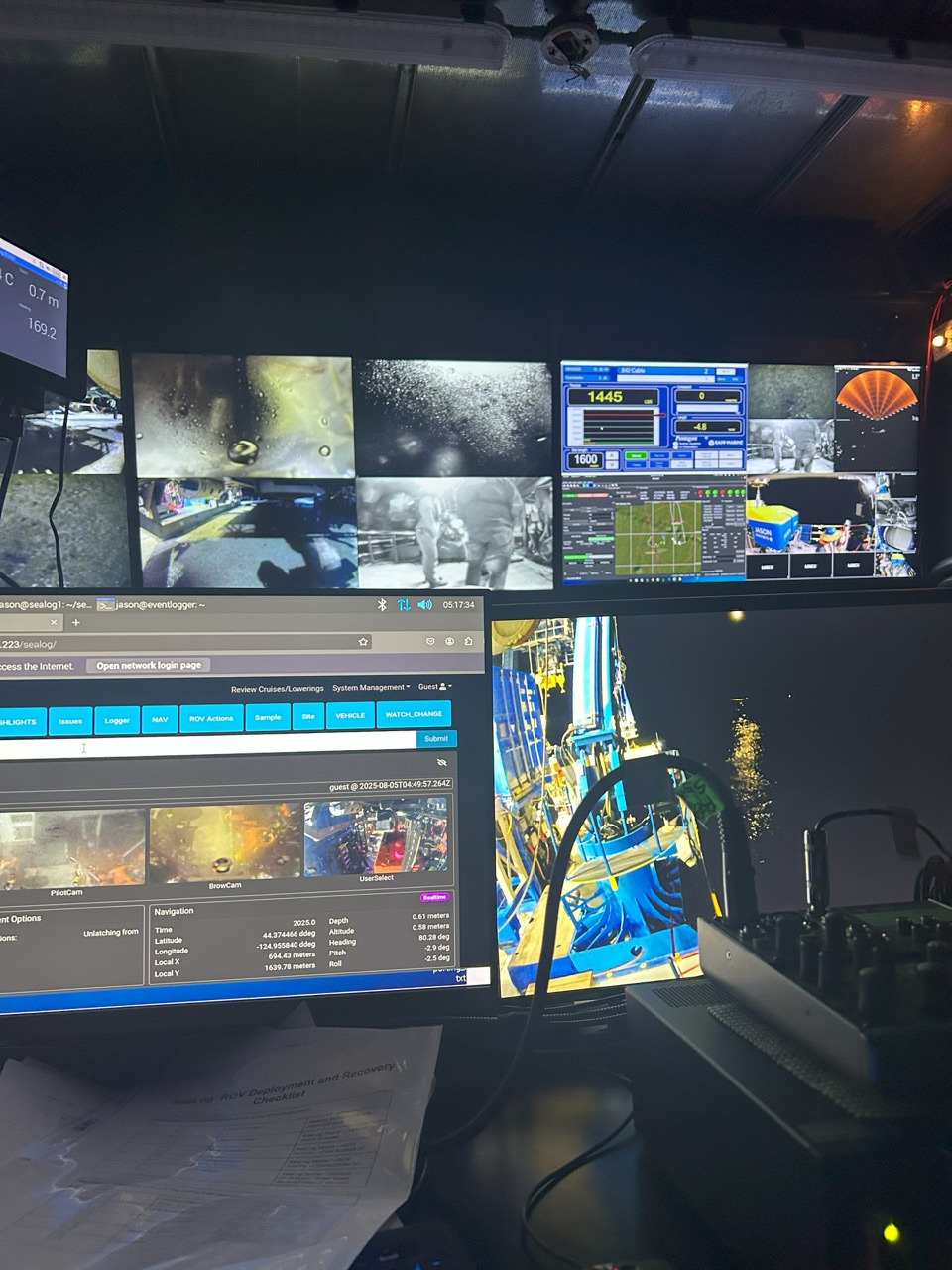
My first watch started at 8pm and went till midnight. It is completely dark in the control van, with the exception of the computer screens. I watched the sunset through a computer showing the camera view from on deck, but I got to see the moon and stars as I left for bed. My role in the Jason watches has been logging key events into Sealog. It’s really a learn as you go process, but by the end of the first couple of hours I had the hang of it. I logged the recovery and deployment for two respective dives that night. We were monitoring and replacing certain equipment and instruments at a couple of sites. We haven’t reached the base of the Axial yet, but are monitoring several sites along the way.
Yesterday was a very long day of learning and constantly adjusting to new situations. After a quick stop on the lower deck to look at the stars after my first shift, I made it back to my bunk for a couple of hours of much needed sleep. In the morning, my shift started at 8am and I jumped right into a CTD recovery. This just means bringing the rosette out of the water and securing it back to the deck. After that, there was yet another JASON dive happening, so I went back into the control van to log the deployment and key events. We kept the vibes going by listening to some classic 2000s pop music as the Jason crew did their thing.
I cannot emphasize enough how interesting it is to watch even the smallest things happening inside the van. One minute you are watching a little crab scuttle away from one of Jason‘s manipulators and the next thing you know, you’ve been in there for three hours.
Tomorrow is going to be a transit day as we make our way to the Axial Base. As cool as all the shallower profilers have been, I am definitely looking forward to finally reaching the seamount!
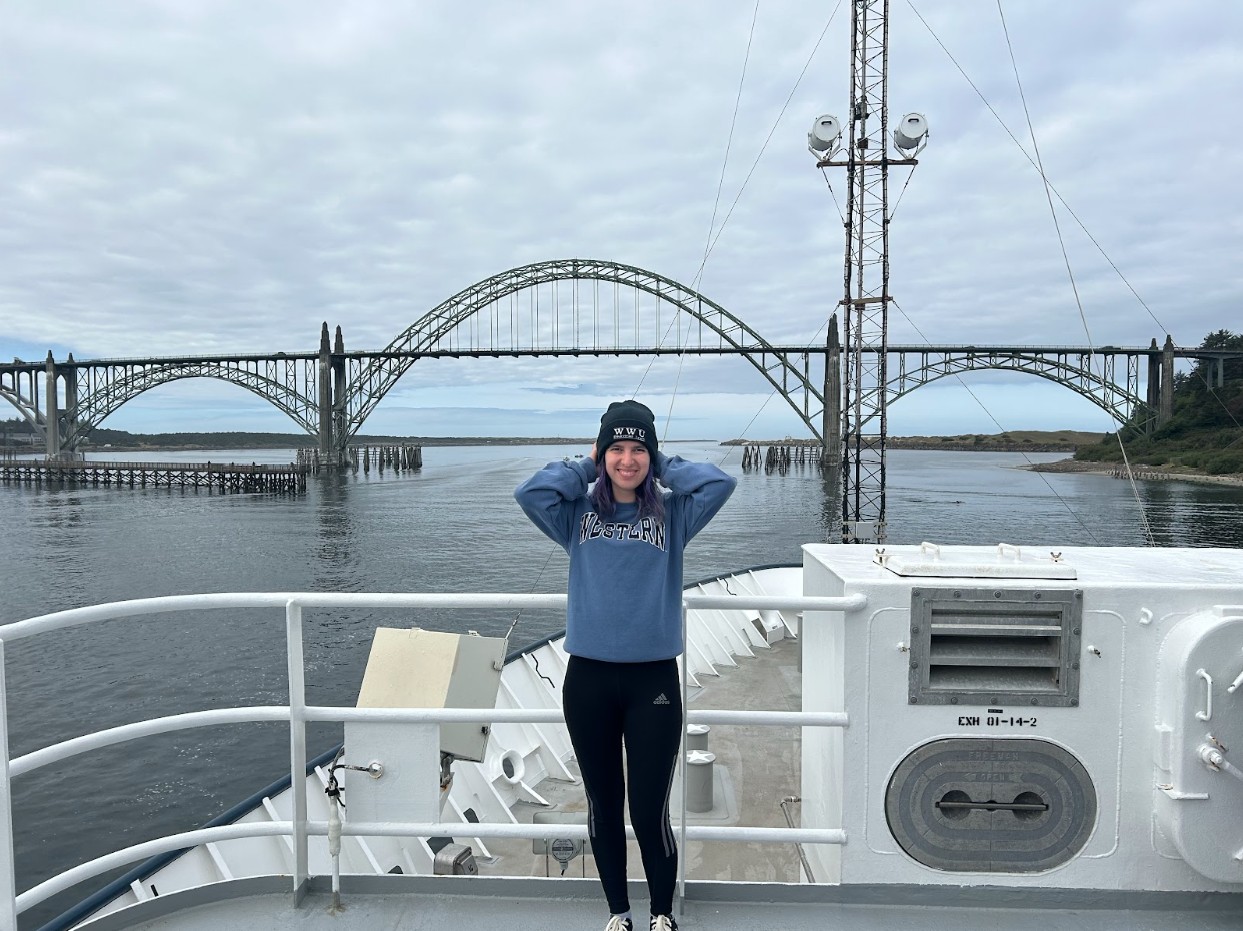
August 4, 2025
I’ve never written a blog before, so bear with me.
We departed Newport around 10 am today after a day in port. It was my first time in the city, so a group of us walked into town the night before to explore and grab dinner on land while we could. I started the day excited, but very anxious about how everything would go. After talking with my fellow students, it became clear that nobody really knew what to expect coming on this trip, which honestly was a comfort. We are all super excited and looking forward to our adventures ahead. The first night went surprisingly well. I slept great and woke up ready for another day.
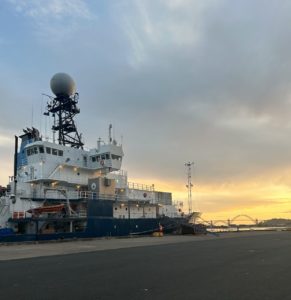
We had a safety drill in the morning where we learned how to put on a full-body immersion suit in an abandon ship scenario and where to meet in case of different emergency scenarios. In the afternoon, we had a Jason orientation. Jason is a remotely operated vehicle (ROV) that has been on countless dives and captured so many incredible discoveries, and it was cool to see it in person and be involved with its dives. We also had a conductivity, temperature, depth (CTD) orientation afterwards, which included setting up the Niskin bottles and preparing the deck for deployment. I have used a CTD before, but this one was much larger, and it was fun to watch it go in and out of the water.
Around midday, I started to feel sick and had to lie down for a while. I have been feeling pretty well since then; just glad to not be nauseous the whole time. I’m still a little out of sorts, and don’t quite have my “sea legs” yet, but I’m ready to adjust!
I’m most looking forward to my first Jason watch tonight. I have two shifts from 8 to 12 each day, so I’m hoping I get to see a variety of events happening at each time. Overall, I am just so happy to be here and learn everything I can. This is such an amazing opportunity and I’m so thankful to have joined this field.
Can’t wait for tomorrow!
